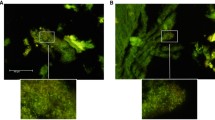Abstract
Sialoliths, the calcified structures that develop within the salivary gland parenchyma and its ductal system, are the major cause of acute and chronic sialadenitis. Various theories of aetiology have been postulated, yet unclear. Aim of our study is to study the submandibular and parotid ductal sialoliths ultra-structurally and chemically to derive its respective mechanism of lithogenesis. Two parotid and a submandibular intraductal sialoliths were retrieved from sialadenitis patients, and each was analysed using high-resolution scanning electron microscope, energy-dispersive X-ray spectroscopy (EDS) and Fourier transform infrared (FTIR) spectroscopy and compared with each other. Scanning electron microscopic analysis of parotid sialoliths revealed irregular scaly pattern of rudely spike-like crystals with tubular porosities which might suggest earlier harbour of bacilli, whereas submandibular sialolith revealed globular, roughly rhombohedral crystals with spherical intercrystal porosities. From EDS analyses, it was evident that levels of calcium and phosphorus found to be three times more in submandibular sialolith than parotid sialolith. FTIR spectroscopic analysis showed more hydroxyl vibration spectra in submandibular sialolith, whereas parotid sialolith showed more amide and CO stretching. Above results suggest that the submandibular sialoliths are composed mainly of inorganic contents while parotid sialoliths predominantly with organic contents. Henceforth, chronic sialadenitis and morpho-anatomical disadvantage of ductal orientation plays a major role in the submandibular sialolith formation while organic nidus in the parotid sialolithogenesis.







Similar content being viewed by others
References
Jaya Chandran S (2010) Submandibular sialoithiasis. Analysis of 4 case reports. J Int Med Sci Acad 23:97
Kraaij S, Karagozoglu KH, Forouzanfar T, Veerman EC, Brand HS (2014) Salivary stones: symptoms, aetiology, biochemical composition and treatment. Br Dent J 217:E23
Jayachandran S, Bakyalakshmi K (2011) Giant submandibular sialolith presenting with sialo-cutaneous and sialo-oral fistula: a case report and review of literature. J Indian Acad Oral Med Radiol 23(3):S491–S494
Nolasco P, Anjos J, Marques J, Cabrita F, Costa EC, Mauricio A et al (2013) Structure and growth of sialoliths: computed microtomography and electron microscopy investigation of 30 specimens. Microsc Microanal 19(5):1190–1203
Jayasree RS, Gupta AK, Vivek V, Nayar VU (2008) Spectroscopic and thermal analysis of a submandibular sialolith of Wharton’s duct resected using Nd:YAG laser. Lasers Med Sci 23:125–131
Hiraide N (1978) Morphological studies on salivary calculi. Jibiinkou 50:241–248
Mishima H, Yamamoto H, Sakae T (1992) Scanning electron microscopy-energy dispersive spectroscopy and X-ray diffraction analyses of human salivary stones. Scanning Microsc 6(2):487–494
Grases F, Santiago C, Simonet BM, Costa-Bauz AA (2003) Sialolithiasis: mechanism of calculi formation and etiologic factors. Clin Chim Acta 334:131–136
Kasaboglu O, Er N, Tumer C, Akkocaoglu M (2004) Micromorphology of sialoliths in submandibular salivary gland: a scanning electron microscope and X-ray diffraction analysis. J Oral Maxillofac Surg 62:1253–1258
Sabot JF, Gustin MP, Delahougue K, Faure F, Machon C, Hartmann DJ (2012) Analytical investigation of salivary calculi, by mid-infrared spectroscopy. Analyst 137:2095–2100
Harrison JD (2009) Causes, natural history, and incidence of salivary stones and obstructions. Otolaryngol Clin N Am 42:927–994
Acknowledgements
We would like to thank Sophisticated Analytical Instrument Facility (SAIF) centre, Indian Institute of Technology, Madras (HR-SEM with EDS) and Department of Medical Physics, Anna University, College of Engineering, Guindy campus, Chennai (FTIR), for providing the required facilities during the course of work.
Author information
Authors and Affiliations
Corresponding author
Ethics declarations
Conflict of interest
The authors declare that they have no conflict of interest to publish this manuscript.
Informed Consent
All three patients’ informed consents for publication were enclosed.
Additional information
Publisher's Note
Springer Nature remains neutral with regard to jurisdictional claims in published maps and institutional affiliations.
Significance Statement Sialolith is the common causative for obstructive salivary gland disease which in turn is one of the most common aetiological factors of sialadenitis, a painful condition of salivary glands. Various theories have been put forth regarding lithogenesis, but unclear. Hence, there is a need to study the sialolith ultra-structurally to figure out the difference between its formation in parotid and submandibular salivary glands.
Rights and permissions
About this article
Cite this article
Sadaksharam, J., Kuduva Ramesh, S.S. Spectroscopic and Microscopic Characterisation of Parotid and Submandibular Ductal Sialoliths: A Comparative Preliminary Study. Proc. Natl. Acad. Sci., India, Sect. B Biol. Sci. 90, 1165–1171 (2020). https://doi.org/10.1007/s40011-020-01189-9
Received:
Revised:
Accepted:
Published:
Issue Date:
DOI: https://doi.org/10.1007/s40011-020-01189-9




